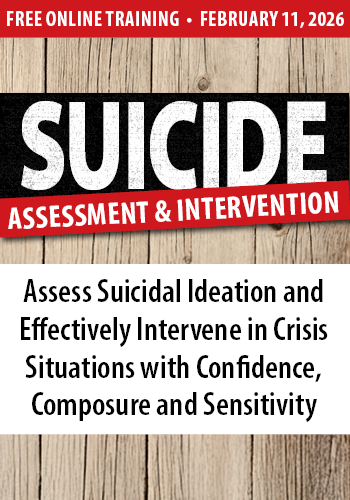Enrol in an online course today for flexible, self-paced learning—no fixed schedule required. Plus, enjoy lifetime access to course materials for convenient revisiting.
Responding to a Suicidal Client: The Practicalities

The thought of a client attempting or dying by suicide while in therapy can cause anxiety, especially for therapists in training or inexperienced therapists. You have a duty of care to keep the client safe. In the worst case you may need to justify your actions in court or at an inquest. Forward planning can help you be clear how to respond, which can reduce your anxiety.
Be prepared by taking the following steps:
Collect contact details and GP details
If I had to attend an inquest after a suicide, I would want to show that I had acted to keep the client safe. Collecting details is part of that. Some organisations do not collect information, so find out their policy for suicidal clients and document it. Discuss it in supervision. Of course, a client could also lie about any information they give.
Contract with care
Contract from the start so clients know what will happen if they are at risk. Explain duty of care, and the possibility you may need to contact a third party such as a GP.
Contracting with warmth and compassion is an important part the therapeutic relationship. It also shows that the work is boundaried and safe.
If, during therapy, your client reveals thoughts of suicide, remind them of the contract. Ascertain if they have a plan, and methods. Ask what stops them from acting.
They have agreed the contract, so maybe they are talking about suicide because they want you to act.
Make a safety plan together
If your client expresses their wish to die and has mentioned a plan and method, discuss and prepare with them a safety plan. This should include:
- How to keep safe
- What helps them stay alive
- Supporting factors
- Who to contact in emergency, such as GP /A&E, and crisis team (if they have had prior contact)
Make sure you both have a copy (or take a photo).
This can remind your client of reasons to keep going, and that they have support. It can break the thought process and reduce suicidal intent.
Be prepared to break confidentiality
If, having explored their thoughts, you feel there is intent and a plan, you need to act – it helps if they consent but you may need to act without this.
If the danger is not immediate, your client should make a GP appointment to discuss their suicidal intent. Help them work out what to say and explain what might happen at the appointment. Possibly offer to call for them. Agree with the client how they will keep safe until the appointment.
GP responses vary. Ideally, they will speak to the client, and discuss their options. Sometimes they tell the client to go straight to A&E and don’t agree to see them. This can be frustrating.
If the risk is immediate, they should attend A&E for assessment with crisis services. Ask if a friend or relative might accompany them. You could call ahead to advise A&E. If you decide to accompany them, risk assess this.
They may choose not to go. There will probably be a long wait but sometimes this is enough for the thoughts and immediate danger to pass. They may not be treated as you hoped, but you have acted ethically in your duty of care.
Should they not give consent, but the risk is a concern, you could call their GP and advise them of the situation.
The GP may not act, but insist they take client details.
If the client leaves before you can act, and are an immediate risk, contact the emergency services.
Keep thorough notes
Keep notes of all your actions and to whom you have spoken. Speak to your supervisor.
Don’t forget self-care
These situations impact emotionally so remember to practise self-care.

















